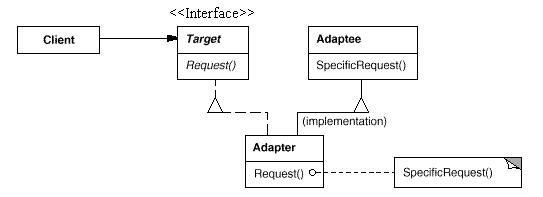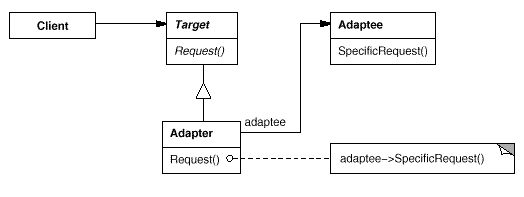一、 适配器(Adapter)模式
适配器模式把一个类的接口变换成客户端所期待的另一种接口,从而使原本接口不匹配而无法在一起工作的两个类能够在一起工作。
名称由来
这很像变压器(Adapter),变压器把一种电压变换成另一种电压。美国的生活用电电压是110V,而中国的电压是220V。如果要在中国使用美国电器,就必须有一个能把220V电压转换成110V电压的变压器。这个变压器就是一个Adapter。
Adapter模式也很像货物的包装过程:被包装的货物的真实样子被包装所掩盖和改变,因此有人把这种模式叫做包装(Wrapper)模式。事实上,大家经常写很多这样的Wrapper类,把已有的一些类包装起来,使之有能满足需要的接口。
适配器模式的两种形式
适配器模式有类的适配器模式和对象的适配器模式两种。
二、 类的Adapter模式的结构:

由图中可以看出,Adaptee类没有Request方法,而客户期待这个方法。为了使客户能够使用Adaptee类,提供一个中间环节,即类Adapter类,Adapter类实现了Target接口,并继承自Adaptee,Adapter类的Request方法重新封装了Adaptee的SpecificRequest方法,实现了适配的目的。
因为Adapter与Adaptee是继承的关系,所以这决定了这个适配器模式是类的。
该适配器模式所涉及的角色包括:
目标(Target)角色:这是客户所期待的接口。因为C#不支持多继承,所以Target必须是接口,不可以是类。
源(Adaptee)角色:需要适配的类。
适配器(Adapter)角色:把源接口转换成目标接口。这一角色必须是类。
三、 类的Adapter模式示意性实现:
下面的程序给出了一个类的Adapter模式的示意性的实现:
// Class Adapter pattern -- Structural example
using System;
// "ITarget"
interface ITarget
{
// Methods
void Request();
}
// "Adaptee"
class Adaptee
{
// Methods
public void SpecificRequest()
{
Console.WriteLine("Called SpecificRequest()" );
}
}
// "Adapter"
class Adapter : Adaptee, ITarget
{
// Implements ITarget interface
public void Request()
{
// Possibly do some data manipulation
// and then call SpecificRequest
this.SpecificRequest();
}
}
/** <summary>
/// Client test
/// </summary>
public class Client
{
public static void Main(string[] args)
{
// Create adapter and place a request
ITarget t = new Adapter();
t.Request();
}
}
四、 对象的Adapter模式的结构:

从图中可以看出:客户端需要调用Request方法,而Adaptee没有该方法,为了使客户端能够使用Adaptee类,需要提供一个包装(Wrapper)类Adapter。这个包装类包装了一个Adaptee的实例,从而将客户端与Adaptee衔接起来。由于Adapter与Adaptee是委派关系,这决定了这个适配器模式是对象的。
该适配器模式所涉及的角色包括:
目标(Target)角色:这是客户所期待的接口。目标可以是具体的或抽象的类,也可以是接口。
源(Adaptee)角色:需要适配的类。
适配器(Adapter)角色:通过在内部包装(Wrap)一个Adaptee对象,把源接口转换成目标接口。
五、 对象的Adapter模式示意性实现: 下面的程序给出了一个类的Adapter模式的示意性的实现: // Adapter pattern -- Structural example using System; // "Target" class Target { // Methods virtual public void Request() { // Normal implementation goes here } } // "Adapter" class Adapter : Target { // Fields private Adaptee adaptee = new Adaptee(); // Methods override public void Request() { // Possibly do some data manipulation // and then call SpecificRequest adaptee.SpecificRequest(); } } // "Adaptee" class Adaptee { // Methods public void SpecificRequest() { Console.WriteLine("Called SpecificRequest()" ); } } /** <summary> /// Client test /// </summary> public class Client { public static void Main(string[] args) { // Create adapter and place a request Target t = new Adapter(); t.Request(); } }七、 一个实际应用Adapter模式的例子 下面的程序演示了Class Adapter与Object Adapter的应用。 // Example of implementing the Adapter pattern using System; // Target public interface ICar { void Drive(); } // Direct use without Adapter public class CToyota : ICar { public void Drive() { Console.WriteLine("Vroom Vroom, we're off in our Toyota"); } } // Adaptee public class CCessna { public void Fly() { Console.WriteLine("Static runup OK, we're off in our C172"); } } // Class Adapter public class CDrivableCessna : CCessna, ICar { public void Drive() { base.Fly(); } } // Object Adapter public class CDrivableCessna2 : ICar { private CCessna m_oContained; public CDrivableCessna2() { m_oContained = new CCessna(); } public void Drive() { m_oContained.Fly(); } } // Client public class Client { public static void Main(string[] args) { ICar oCar = new CToyota(); Console.Write("Class Adapter: Driving an Automobile"); oCar.Drive(); oCar = new CDrivableCessna(); Console.Write("Driving a Cessna"); oCar.Drive(); oCar = new CDrivableCessna2(); Console.Write(" Object Adapter: Driving a Cessna"); oCar.Drive(); } }
六、 在什么情况下使用适配器模式
在以下各种情况下使用适配器模式:
1、 系统需要使用现有的类,而此类的接口不符合系统的需要。
2、 想要建立一个可以重复使用的类,用于与一些彼此之间没有太大关联的一些类,包括一些可能在将来引进的类一起工作。这些源类不一定有很复杂的接口。
3、 (对对象适配器而言)在设计里,需要改变多个已有子类的接口,如果使用类的适配器模式,就要针对每一个子类做一个适配器,而这不太实际。
八、 关于Adapter模式的讨论
Adapter模式在实现时有以下这些值得注意的地方:
1、 目标接口可以省略,模式发生退化。但这种做法看似平庸而并不平庸,它可以使Adaptee不必实现不需要的方法(可以参考Default Adapter模式)。其表现形式就是父类实现缺省方法,而子类只需实现自己独特的方法。这有些像模板(Template)模式。
2、 适配器类可以是抽象类。
3、 带参数的适配器模式。使用这种办法,适配器类可以根据参数返还一个合适的实例给客户端






















 654
654

 被折叠的 条评论
为什么被折叠?
被折叠的 条评论
为什么被折叠?








